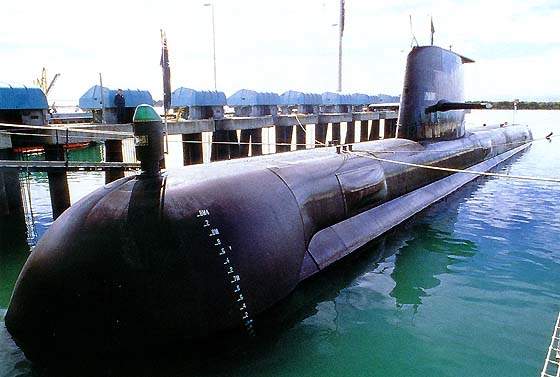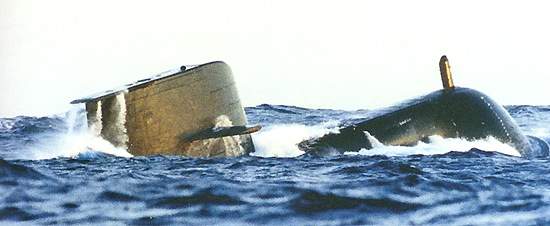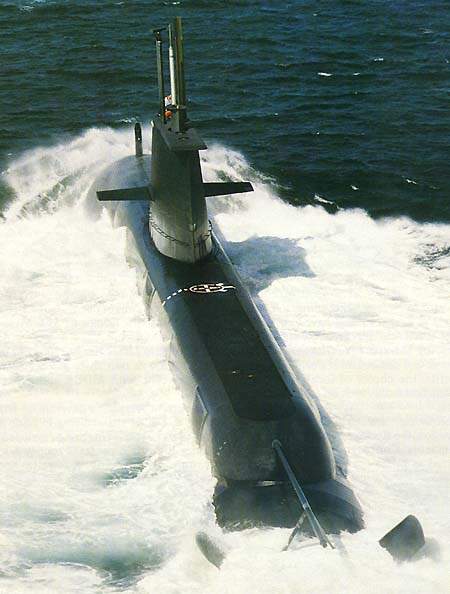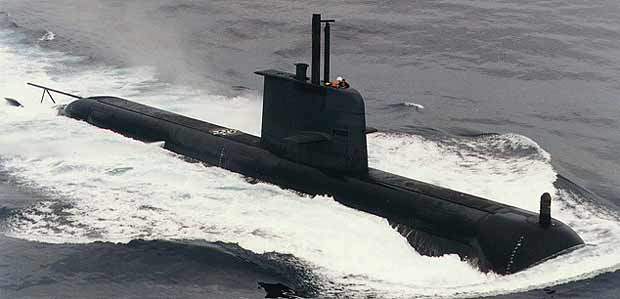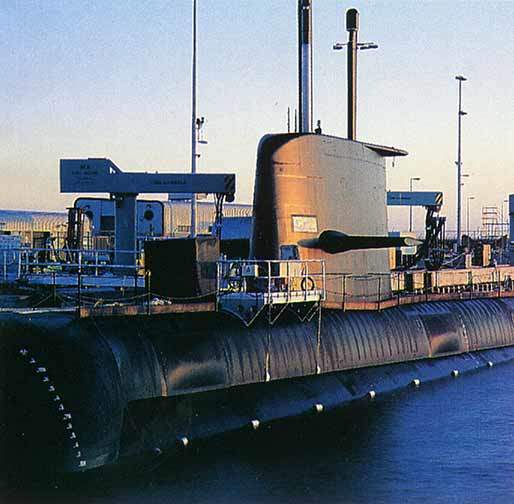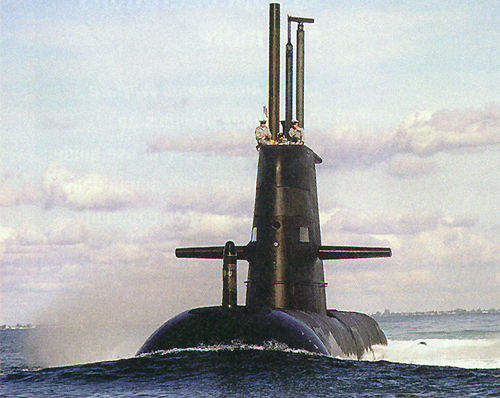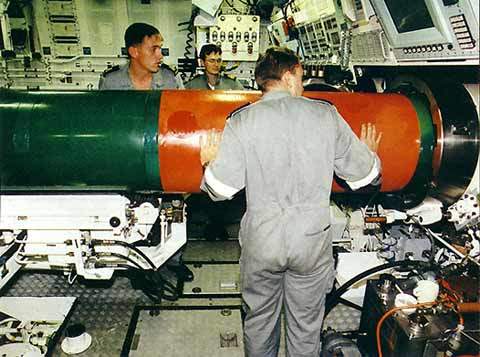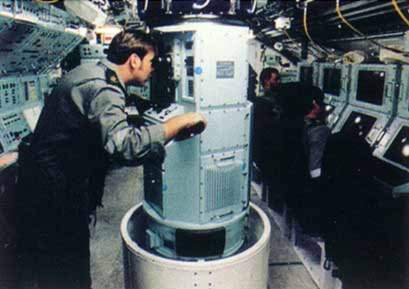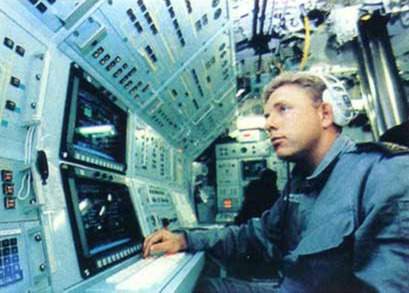The Collins Class type 471 diesel-electric submarines were designed by Swedish shipbuilders Kockums for the Royal Australian Navy. Construction was carried out by ASC, formerly the Australian Submarine Corporation, in Adelaide, South Australia, although the bow and escape tower sections of the first submarine were built in Sweden.
The first of class, HMAS Collins (73), was commissioned in 1996. HMAS Farncomb (74) was commissioned in January 1998, HMAS Waller (75) in February 2001, HMAS Dechaineux (76) in February 2001, HMAS Sheean (77) in November 2000 and HMAS Rankin (78) in March 2003. The submarines are based at Cockburn Sound in Western Australia.
In March 2004, the Royal Australian Navy accepted the “operational release” of the six Collins Class submarines.
Collins Class submarine upgrade programme
The Australian Department of Defence has upgraded four of the Collins Submarines – HMAS Dechaineux, Sheean, Farncomb and Rankin. The programme was completed in March 2003.
The upgrade programme was designed to rectify shortcomings identified in a government report and included: upgrades to weapon systems; improvements to the sonar system, tactical data handling system and weapons control system; upgrade and improvement of the combat system and operational fixes to reduce acoustic signature.
The RAN decided to acquire a replacement combat system (RCS) which is a variant (block 1C mod 6) of the Raytheon CCS mk2 in service with the US Navy. The RAN signed an agreement with the US Navy in November 2004 for the development of the system, called the AN/BYG-1 combat control system, which is also being fitted to USN Virginia Class submarines.
The mk48 mod 7 ADCAP (advanced capability) torpedo, which entered service in 2008, was also being under an armaments cooperation project with the USN. Thales Underwater Systems is providing new sonar suite displays and processors for the Scylla sonar to be integrated with the CCS mk2.
The first AN/BYG-1 combat control system was delivered in January 2006 and HMAS Waller is the first submarine to be upgraded with the combat system and heavyweight torpedoes. The installation was completed in April 2007 and the submarine took part in the RIMPAC exercises in Hawaii in June 2008 where it became the first submarine to fire the mk48 mod 7 common broadband advanced sonar system (CBASS) heavyweight torpedo. HMAS Dechaineux was the fourth submarine to complete the upgrade in May 2010. The combat system upgrade programme is scheduled for completion in 2010.
In October 2006, Sagem Défense Sécurité was awarded a contract to equip the Collins submarines with the SIGMA 40XP gyrolaser inertial navigation system.
Also in October 2006, the RAN announced approval for the Collins continuous improvement program, which constitutes a rolling upgrade approach. Future improvements being considered are to communications, electronic warfare and periscope optronic sensor systems.
Combat systems
Rockwell was the original sub-contractor for the legacy combat system. After a series of acquisitions of the relevant businesses, Raytheon Australia maintains the current system.
Torpedoes
The Collins Class has the capacity for up to 22 missiles and torpedoes, and up to 44 mines in place of torpedoes. There are six 533mm forward torpedo tubes with air turbine pump discharge.
Collins carries the Gould mk48 mod 4 torpedo, which is a wire-guided torpedo with active / passive homing and 267kg warhead. Range is 38km at 55kt or 50km at 40kt. Collins can also carry the BAE Systems Stonefish mkIII mines.
Sub Harpoon anti-ship missiles
The surface-to-surface missile is the Boeing Sub Harpoon anti-ship missile, which is equipped with active radar homing. The range is up to 30km and the speed Mach 0.9. Sub Harpoon carries a warhead of 227kg.
Countermeasures
The ES-5600 system is the electronic support sensor provided by EDO. The EDO ES-5600 ESM system operates in the 2GHz to 18GHz radar band and provides automatic detection, direction finding and identification of radar signals. An EDO Argo Systems AR-740 electronic support measures unit is also fitted.
The Collins class carries two Strachan and Henshaw submerged signal and decoy ejectors (SSDE). The SSDE forged unit containing the ejector barrel and water ram is welded into the hull.
Sensors
The I-band navigation radar is the Kelvin Hughes Type 1007 consisting of an antenna unit, a transmitter / receiver and a display. The transmitter / receiver unit operates at 9.410GHz with transmitter power output at 25kW. Collins is equipped with Thales (formerly Pilkington Optronics) CK043 search periscope and CH093 attack periscope, which incorporate a suite of thermal imagers, image intensifiers and low-light television sensors.
Collins deploys the Thales Underwater Systems Scylla active and passive bow array sonar and passive flank, intercept and ranging arrays. The planar sonar array is constructed from flat panels of piezo-electric polyvinyl difluoride which provide bearing data to determine range using low frequencies up to 10kHz.
Collins can be fitted with either the Kariwara or the Namara thin-line reelable array. These are high-gain digital surveillance streamers supplied by Thales Underwater Systems.
The towed arrays are also fitted on Australia’s Oberon Class submarines and were developed in conjunction with the Australian Defence Research Centre.
Propulsion systems
The Collins class is equipped with three Hedemora / Garden Island Type V18B/14 four-stroke turbo charged diesel engines, each providing 1,475kW. Jeumont Schneider of France supplies the three 1,400kW 440V DC generators.
The main motor is a water cooled DC shunt, double armature motor with rated power of 5,250kW. Emergency propulsion is provided by a MacTaggart Scott DM 43006 retractable hydraulic motor. There is one shaft and a skew back propeller.

